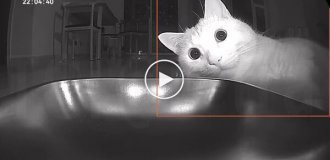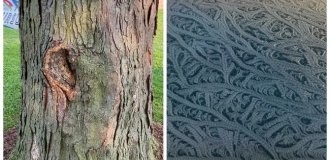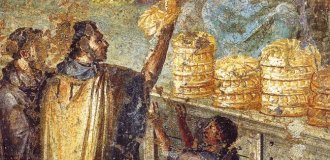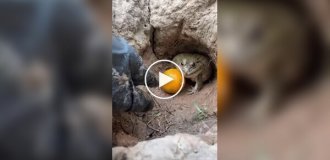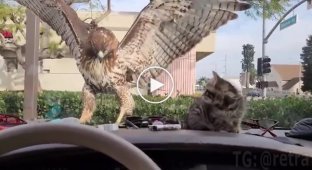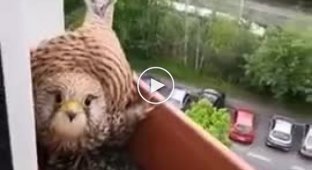Hawk wasp: its venom can only make you fall to the ground and scream (9 photos)
Somewhere in the scorching desert, under the sun that cracks the earth, a giant palm-sized tarantula slowly crawls out of its hole. A strong, ruthless, ferocious hunter - the pride of the spider tribe. 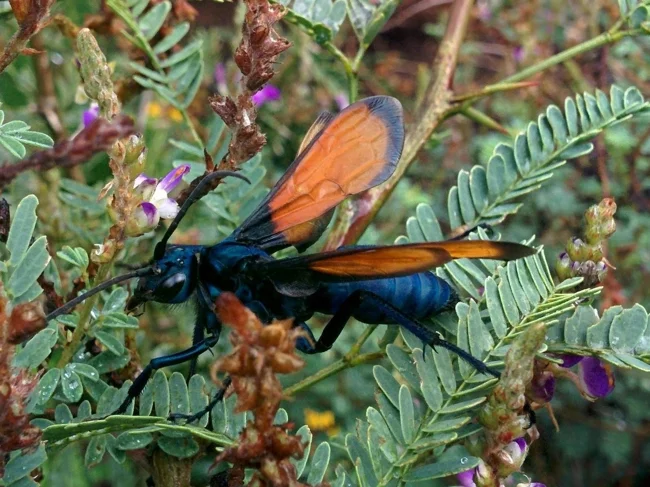
These are the kind of wasps that live in a country toilet.
But today he himself will become prey. A low hum is heard in the distance, a blue-black silhouette approaches the hole. A moment, and the mighty eight-legged predator is paralyzed with pain. Running is useless, fighting is pointless. The hawk wasp has collected its harsh harvest. And is flying towards you.
Okay, we're kidding. The hawk wasp, or tarantula hawk, is not found here. And that's great! The arthropods that flew off onto the head are at the top of two ratings at once. Firstly, it is the largest hymenopteran insect in the world. Do you know bees, hornets and bumblebees? Well, this is their evil older sister. The beasts grow up to 5 cm in length with a wingspan of up to 7 cm. That's 10 times larger than an ordinary bee! 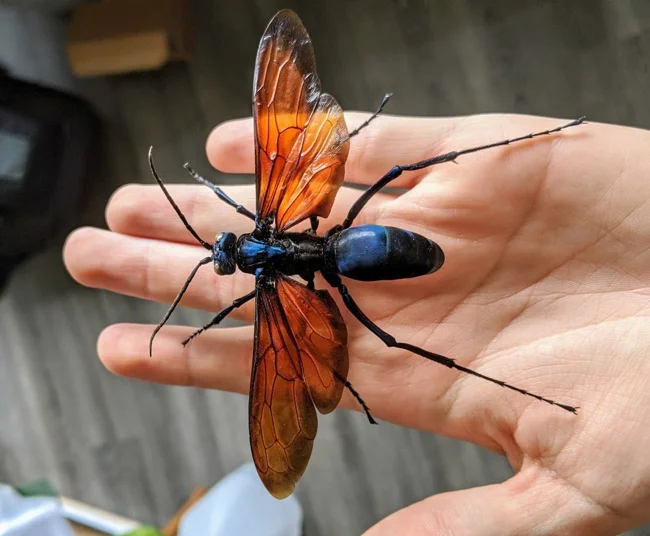
Just imagine the noise it makes when it flies!
Secondly, the wasp's venom is the second most painful of all insects in the world! It instantly attacks the nerve endings, causing a burning, unbearable pain from which there is no escape. You won't even be able to move, you'll just fall to the ground and scream. 
Didn't your mother teach you not to point your fingers at others? No? Then I'll teach you some manners!
But there are also advantages. Advantage number one: although wasp poison causes hellish torment, it is absolutely safe. You will be surprised, but more people die from ordinary bees than from these evil creatures! A person will, of course, suffer greatly, but will not die and will not receive any serious consequences for his health. This is the whole point of their poison - not to kill, but to scare away. It works great - even other insects have figured this out and started wearing the same black and orange colors to look like wasps. 
You don't have to be a fashion savant to be a trendsetter. Just terrify everyone around you - then everyone will want to look like you!
Plus number two: the wasp lives exclusively in Central America. This means you won't meet it walking through a field of birch trees. Plus number three: these arthropods are absolutely not interested in people. Yes, sometimes wasps fly into gardens and parks, but they usually live in prairies and deserts. 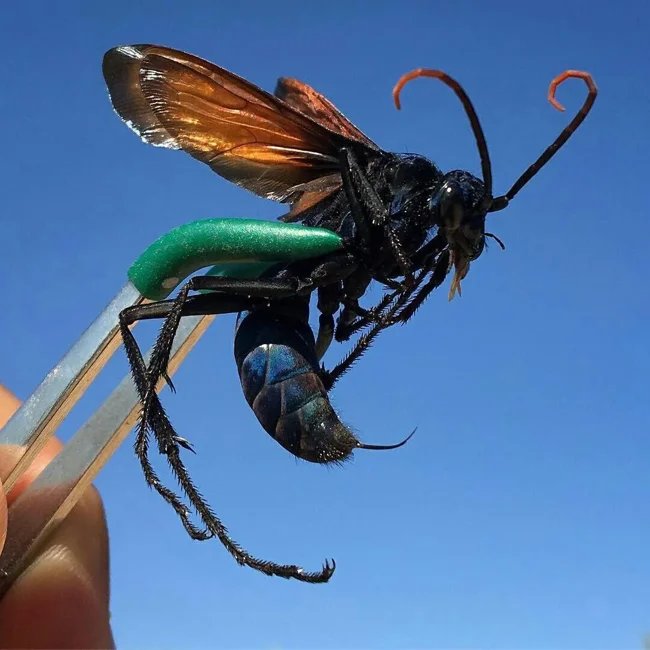
Holding such a wasp in your hands is safe for your health only at the distance of an outstretched tweezers.
Of course, you wouldn't say it from the outside, but this super-poisonous monster lives the life of a very ordinary bee: it eats nectar, flutters from flower to flower, pollinating them along the way. And it also looks out for spiders. And not just any spiders, but huge tarantulas! But wasps don't eat them. Because the best things are for children. 
Even such toxic ladies need flowers!
A pregnant female with hawk-like precision searches for a spider's shelter. Tarantulas do not weave ordinary webs, they are too heavy to move along the web. Their lair is a shallow hole with a "lid"-hatch made of earth. Having found one, the wasp lures the future victim out. 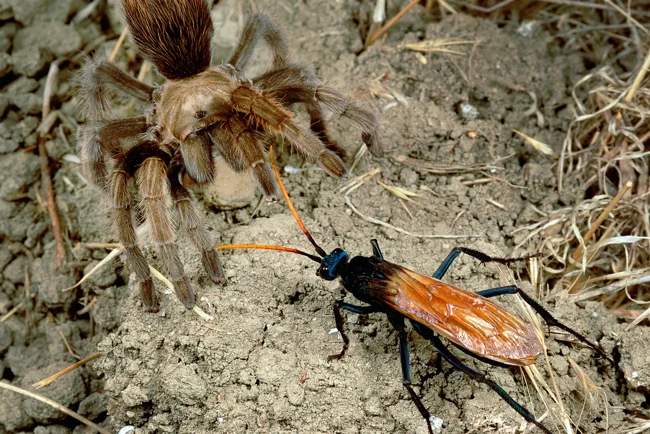
— Hello, I'm your new neighbor. — Around the house? — No, around the apartment!
The spider can be twice as big as the huntress herself and several times heavier, but it's not the weight that counts, but the poison and agility. The wasp spurred the tarantula on to defend itself, vibrating its wings and releasing a special set of pheromones-aromas from the glands under its lower jaws. It smells like a caustic detergent and, apparently, the spiders don't like it very much. Trying to defend itself from the buzzing misfortune, the tarantula stands on its hind legs — and that's it, the fight is over. The lady plunges her sting into the victim's abdomen and with surgical precision strikes the nerve node of the arthropod. It is difficult to imagine the pain the spider experiences, but, alas, the tarantula's suffering does not end there. 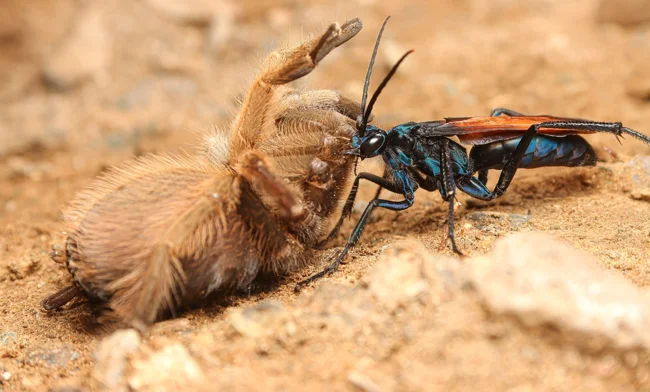
Does it hurt? Don't worry, it will hurt even more!
The wasp drags the paralyzed but alive spider into the hole. And then lays an egg on its immobilized carcass. What's surprising is that wasps can "plan the gender" of their baby. If she gets a very small and skinny spider, the wasp will give birth to a boy. Males have the easiest job - find a female and fertilize her. They don't have to grow big. But if the mother kills a healthy, fat spider, she'll have a daughter. Here's your gender party! The young female needs to eat a lot, which is what she'll be doing for the next couple of weeks. 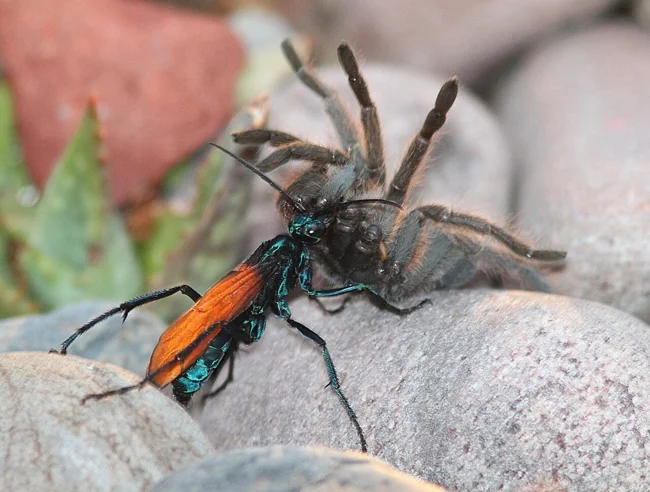
Hello! I don't know you at all, but I invite you to a gender party. If you don't come, I'll drag you there by force!
The larva is in no hurry to eat its live canned food. Mom tried to pump the spider full of poison, so it won't run away. First, the most "unimportant" things are eaten - fat, muscles and the digestive system. This way, the tarantula won't throw off its legs ahead of time. Then, just before pupation, the baby eats the nervous system and heart. Then comes the pupa stage and a pause - the adult wasp will appear on the surface only the following year. Dressed in black chitinous armor, armed with wings and one of the most powerful poisons in the insect world, it will keep the harsh lands of the old Wild West in fear.

